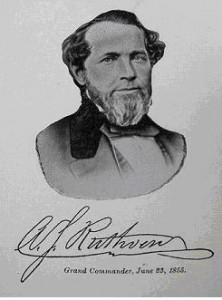Alfred Reid
Thursday, July 24th, 2014Roy Family
Monday, April 4th, 2011The ROY family lived locally in St James Road. James Roy was a housepainter. He came from Edinburgh. His wife Martha may have worked for Collins the printers before her marriage. She had been brought up in the Drygate close to the Glasgow Necropolis. Her father, John BARR, was a calenderer or clothlapper in the mills. 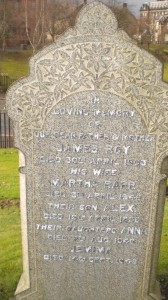
James and Martha’s eldest child was their only son, Alexander. They had 5 daughters, Martha, Catherine, Mary, Jemima, and Anna. The headstone was probably commissioned by Martha and Mary who lived with their mother, Martha ROY until her death in 1946. The grave is close to the Wishart Street gates. It is the 9th on the left as you walk up the path towards the bridge from there.
The first to be buried in this lair was Alexander Roy. He died on the 19th April 1898 at the age of 18 in Glasgow Royal Infirmary. The cause of death is given as Bright’s Disease but it is possible that this diagnosis was wrong and that he died from Weil’s Disease (leptospirosis). His death followed an accident when Alexander and a friend had been fooling about at the Forth and Clyde Canal. Alex fell in. His friend, a nephew of Professor Glaister of Glasgow University, fished him out and took him to the Glaister home where his clothes were dried before he returned to his own home so that his family would not worry about what had happened. Infection and death followed. Alexander was buried in the Glasgow Necropolis on 21 April 1898 .
5 years later Alexander’s father, James ROY died too at the age of 50 as a result of a fatal accident. He was killed while painting the Council Hall in Municipal Buildings (City Chambers) in preparation for a visit by the King Edward VII and Queen Alexandra on 14 May 1903 . The main purpose of the visit was to lay the foundation stone of the new building of the Glasgow and West of Scotland Technical College which later became the University of Strathclyde but, among other engagements, they attended a luncheon in the City Chambers.
The Evening Times of 30 April, 1903 reported:-
“Fatality in Municipal Buildings
This forenoon a painter working on a scaffold in the Council Hall, Municipal Buildings became suddenly ill and fell a distance of 14 feet. He was conveyed in an unconscious condition to the Royal Infirmary where he died 10 minutes afterwards.”
A Fatal Accident enquiry was held and the entry in the Register of Corrected Entry, issued by the procurator fiscal’s office on 10 August, 1903, noted that a jury had determined that he had died as a result of injuries sustained the same day when he overbalanced and fell from a plank to the ground about 14 feet below.
James ROY’s wife Martha lived to the age of 92. She died on 3rd April 1946 at her home in Dennistoun. She too was buried in the family lair in the Glasgow Necropolis.
The headstone is also in memory of two daughters of James and Martha. They were both buried in Providence, Rhode Island, USA.
Anna, the youngest daughter, married an army officer, George Edward Miller during WW1. Sadly he did not survive the war. Anna was left with a pension which gave her independence. She emigrated to the USA where she became social secretary to a wealthy socialite in Rhode Island. Her sister Mima, emigrated later. She had worked in Glasgow as a dress designer for Dalys’. In the States, she designed clothes for Macey’s in New York.
Both sisters died from breast cancer in their 40s.
Archibald St. Clair (Sinclair) Ruthven
Thursday, March 31st, 2011This profile was researched and written by Ashley Jameson.
ARCHIBALD ST. CLAIR (SINCLAIR) RUTHVEN was born on September 25, 1813 in Edinburgh (Canongate parish) to James Ruthven Jr., a printer in Edinburgh, and his wife Margaret Sinclair. He was the youngest of four siblings: Jean St. Clair (born 1807), James (1809), and Margaret (1811).1
Little is known about Ruthven’s early years in Edinburgh, as he immigrated to the United States in 1832, and, apart from occasional travel, remained in the States until around the time of his death.
By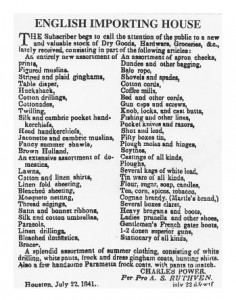 age 23, Ruthven was a merchant pursuing business in the New York City area, and it is likely that he met and married his wife, a native New Yorker by the name of Jane Ann Coats, around this time.2 In 1840, the couple moved to Houston, Texas where A.S. Ruthven and his associate Charles Power operated an English Importing House that sold a variety of imported dry goods, hardware, groceries and other “articles,” and where he sold passage on ships bound for England.
age 23, Ruthven was a merchant pursuing business in the New York City area, and it is likely that he met and married his wife, a native New Yorker by the name of Jane Ann Coats, around this time.2 In 1840, the couple moved to Houston, Texas where A.S. Ruthven and his associate Charles Power operated an English Importing House that sold a variety of imported dry goods, hardware, groceries and other “articles,” and where he sold passage on ships bound for England.
Just one year after his arrival in Houston, Ruthven was initiated into the state’s first Masonic lodge, Holland Lodge No. 1, and very quickly advanced through its ranks, serving first as Senior Warden in 1842, and later in a wide variety of both elective and appointive offices for the Grand Lodge of Texas, chief among which being those of Grand Master (1846-1847), and Grand Secretary (1848-1861). It was during his time as Grand Secretary that Ruthven compiled the two-volume Proceedings of the Grand Lodge of Texas: 1837-1857, a chronicle of the early history and important records of the organization for which he is most recognized within the Masons.3
In addition to Freemasonry, Ruthven was also active with the Knights Templar of the Indivisible Friends Commandery No. 1 at New Orleans, and later the Ruthven Commandery No. 2 at Houston which was so named in his honor. Both he and his wife Jane were also members of Christ Church in Houston.4
In 1844, Ruthven became involved in protesting the annexation of the Republic of Texas to the United States. Along with a group of other British residents in the area, Ruthven composed a Memorial to the Earl of Aberdeen, Queen Victoria’s principal Secretary of State, urging “Her Majesty’s Govt…to guard against any project inconsistent with the Political Independence of the Republic.” Most of the 32 signers of the Memorial were, like Ruthven, “engaged in Commercial pursuits,” and feared that annexation would give the United States the “power to establish a Monopoly of North American Commerce” as well as “complete ascendancy” in the affairs of the continent.5 Though ultimately unsuccessful, the Memorial serves as another testament to Ruthven’s continued involvement in business and community affairs both locally and internationally.
Around 1855, Ruthven and his wife relocated 50 miles Southeast to Galveston, Texas, at which time he began serving as the Texas Representative in cotton purchasing of Nelson, Clements & Co. of New York, and by 1857, of Powell & Ruthven of Galveston. Business appears to have been steady for Ruthven – so much so that in 1860 a steamboat, the A.S. Ruthven, was commissioned to haul cotton along the Trinity River between the ports of Magnolia and Galveston. By 1861, however, she had been leased to the Texas Marine Department for use as a transport vessel during the Civil War. The recovered anchor of the A.S. Ruthven remains on display in Palestine, Texas as a tourist attraction to this day.6
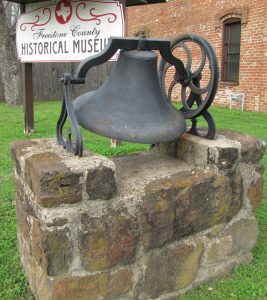
Bell from the A. S. Ruthven
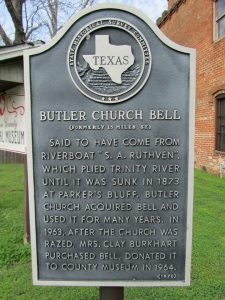
Texas Historical Marker – Butler Church Bell
Ruthven was himself involved in running the blockade of the Texas coast during the war, and was even incarcerated for a time in Matamoras as a result of a freight mishap which purportedly violated the revenue and neutrality laws of Mexico.7 Near the end of the war, Ruthven and his wife returned to Scotland for a visit, at which point he appears to have fallen ill for several months.8
A.S. Ruthven died of tuberculosis on July 24, 1865 at Broomhill Cottage in Pollokshields. He was interred in an unmarked grave in the Iota section of the Necropolis on July 27th. Ruthven was remembered by the Grand Lodge of Texas as “much beloved by all who knew him for his many qualities of heart and mind, for his genial nature and generous impulses.”9 He left behind his wife Jane who returned to Texas after his death, and survived him by two years. She was interred at a Masonic cemetery in Houston, Texas. The couple had no children.
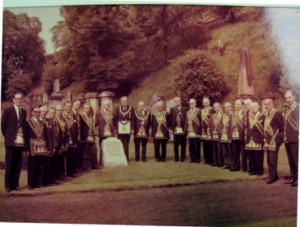 Over a century after his death, the reverend R. Bruce Brannon, a past Grand Master of the Texas Freemasons, arranged for a monument to be commissioned in the Glasgow Necropolis to honour Ruthven and to serve as a proper gravemarker. A commemorative dedication ceremony was held on June 25, 1969, and was attended by several members of both the Grand Lodge of Scotland and the Grand Lodge of Texas.10
Over a century after his death, the reverend R. Bruce Brannon, a past Grand Master of the Texas Freemasons, arranged for a monument to be commissioned in the Glasgow Necropolis to honour Ruthven and to serve as a proper gravemarker. A commemorative dedication ceremony was held on June 25, 1969, and was attended by several members of both the Grand Lodge of Scotland and the Grand Lodge of Texas.10
1Access to birth and death records of all Ruthven children courtesy of ScotlandsPeople (http://www.scotlandspeople.gov.uk), Last accessed October14, 2010.
2 Donavon Duncan Tidwell, “Archibald St. Clair Ruthven,” The Texas Freemason (Summer 1980): 16-19.
3 Barbara Mechell, “A.S. Ruthven: Past Grand Master of the Grand Lodge of the Republic of Texas,” Messenger 2, no. 4 (Spring 2001). The Proceedings were published by Ruthven in 1860.
4 Angela Boswell, “The Meaning of Participation: White Protestant Women in Antebellum Houston Churches,” The Southwestern Historical Quarterly 99, no. 1 (1995): 39.
5 Letter from Ruthven and Others to the Earl of Aberdeen 1844, A.S. Ruthven File, the Masonic Grand Lodge Library and Museum of Texas.
6 Robert M. Hayes, “East Texas Note Book,” Dallas Morning News, 22 January 1960, sec. I, p. 9.
7 Tidwell, 17. (Citation referenced in a letter to Dr. James D. Carter, A.S. Ruthven file, the Masonic Grand Lodge Library and Museum of Texas).
8 Death Record of A.S. Ruthven, http://www.scotlandspeople.gov.uk), Last accessed October14, 2010.
9Grand Lodge of Texas news clipping from 1865, A.S. Ruthven File, the Masonic Grand Lodge Library and Museum of Texas.
10 “Masonic News,” Glasgow Evening Citizen, 20 June 1969.
Image Credits:
Jane Ruthven’s gravestone in Houston, TX © The Masonic Grand
Lodge Library and Museum of Texas, reproduced with permission
Anchor from the Steamboat Ruthven, Photograph, ca. 1920; University of North Texas Libraries, The Portal to Texas History crediting Anderson County Historical Commission, Palestine, Texas.
Powell & Ruthven advertisement in the Texas Almanac for 1857], Digital Image courtesy of the Library of Congress American Almanac Collection
Archibald St.Clair Ruthven picture: © The Masonic Grand Lodge Library and Museum of Texas, Reproduced with permission
Ruthven memorial stone commemoration ceremony: © The Masonic Grand Lodge Library and Museum of Texas, Reproduced with permission









